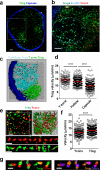Imaging regulatory T cell dynamics and CTLA4-mediated suppression of T cell priming
- PMID: 25653051
- PMCID: PMC4347855
- DOI: 10.1038/ncomms7219
Imaging regulatory T cell dynamics and CTLA4-mediated suppression of T cell priming
Abstract
Foxp3(+) regulatory T cells (Tregs) maintain immune homoeostasis through mechanisms that remain incompletely defined. Here by two-photon (2P) imaging, we examine the cellular dynamics of endogenous Tregs. Tregs are identified as two non-overlapping populations in the T-zone and follicular regions of the lymph node (LN). In the T-zone, Tregs migrate more rapidly than conventional T cells (Tconv), extend longer processes and interact with resident dendritic cells (DC) and Tconv. Tregs intercept immigrant DCs and interact with antigen-induced DC:Tconv clusters, while continuing to form contacts with activated Tconv. During antigen-specific responses, blocking CTLA4-B7 interactions reduces Treg-Tconv interaction times, increases the volume of DC:Tconv clusters and enhances subsequent Tconv proliferation in vivo. Our results demonstrate a role for altered cellular choreography of Tregs through CTLA4-based interactions to limit T-cell priming.
Figures







References
-
- Sakaguchi S, Yamaguchi T, Nomura T, Ono M. Regulatory T cells and immune tolerance. Cell. 2008;133:775–787. - PubMed
-
- Wildin RS, Freitas A. IPEX and FOXP3: clinical and research perspectives. J Autoimmun. 2005;25(Suppl):56–62. - PubMed
-
- Wing K, et al. CTLA-4 control over Foxp3+ regulatory T cell function. Science. 2008;322:271–275. - PubMed
Publication types
MeSH terms
Substances
Grants and funding
LinkOut - more resources
Full Text Sources
Other Literature Sources
Molecular Biology Databases

